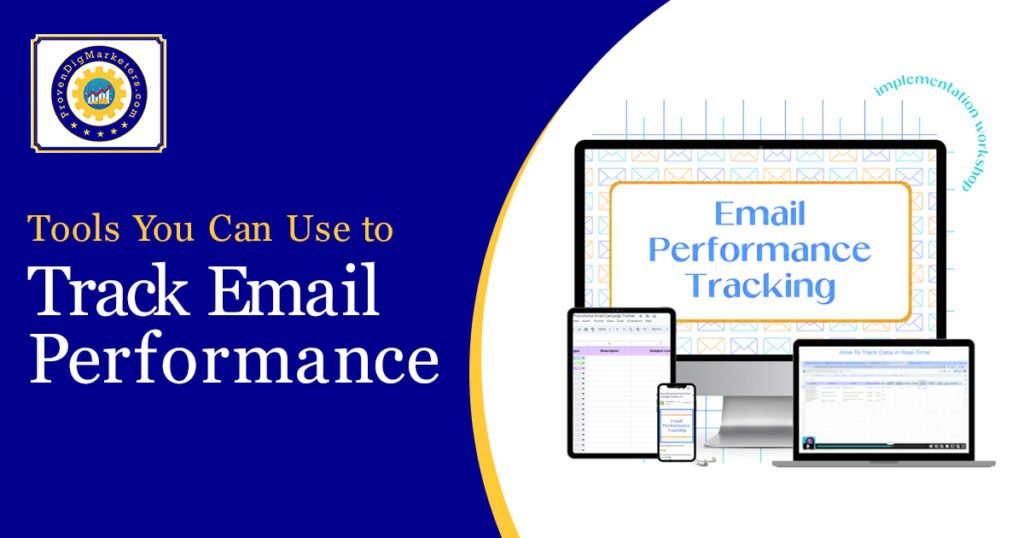How to Track Your Email Campaigns? Today, in the present business world, email marketing undoubtedly is the strongest medium of communication with the customers of any business enterprise. However, such a strategy can be effective only after a business sets up concrete policies for a while, so it is pretty important to know how such a strategy works for them. Measurable Metrics: A company can’t deny to their management that they are bringing a return unless they have a feel for certain metrics. Here’s a closer look at tracking your email campaigns and the key metrics you’ll be tracking. We’re going to cover a few of the tools you can use regarding tracking email performance and then touch on why it could be particularly to your campaign’s advantage to engage with an email marketing agency to reach its full potential that how to track your emails campaign.

Why Track Email Campaigns?
Well, the point is that any email campaign generally is driven by details. This makes marketers take a clear understanding of engagement from email campaigns and then improve the content with that tracking. Hence, they may see good results by an objective, whether in sales, traffic, or brand awareness.
This will let businesses know what the target audience prefers, and then adjust their strategy in that direction, where they will be able to provide an experience that customers like.
8 Email Campaign Metrics Everyone Should Know
Here are eight must-know email campaign metrics that every marketer needs to know about tracking email campaigns:

1. Open Rate:
Open rate: This refers to the percentage of opened emails by the recipient against the total delivered emails. This denotes the capability of the subject line of your email to catch people’s attention. A bad subject line that doesn’t communicate anything of interest will be reflected by low open rates while perhaps no emails are reaching the inboxes of recipients.
2. Click-Through Rate (CTR):
A CTR counts the number of recipients who clicked on one or more links contained in an email. It is pretty important as it highlights how attractive your content is for readers and how effective your CTA is in resonating with readers. A high CTR would mean that your content and CTAs are worthy and convincing.
3. Conversion Rate:
Conversion rate-“How many recipients will click on the link and, in response, fulfill the desired action often, buying or registering for a webinar. It is the direct measure of the degree to which your email campaign affects your business goal. High rates of conversion mean that the content of your e-mail persuades its users into action.
4. Bounce Rate:
Bounce rate is the count of those e-mails that do not land in the inbox of the targeted recipients. Bounces are also termed as “hard” or “soft”. Hard bounces are those that arise due to non-existent or invalid types of addresses; soft bounces occur due to time-specific reasons like an inbox full of mail. Maintaining control over bounce rates helps you maintain a healthy list.
5. Unsubscribe Rate:
It is the number of subscribers who go on to unsubscribe from your list after some campaign. If you happen to notice a high number of unsubscribers then, in most cases, it may mean that the content being emailed out is irrelevant or maybe you are emailing them too often. Keeping a tab on this will enable you to filter and clean the email lists you normally use for campaigning with interested people.
6. Growth Rate:
Growth rate means the incremental increase in size over some time. This lets marketers know if or not your subscriber list is growing and, more importantly if a new subscriber is coming in. A good growth rate for your email list will tell you that your campaigns are attractive enough and worthy enough for subscribers to subscribe and stay on.
7. Email Sharing/Forwarding Rate
This measures how many percent of recipients forward your email to other people. It could be a marvelous lead generation trigger for brand awareness and reach if they think that your content is worth having them share with friends, their colleagues, or peers
8ROI
Measuring E-mail Marketing ROI E-mail marketing return on investment is simply revenue one gets from running a particular email campaign compared to the cost of running that specific email campaign. This measurement of ROI is quite crucial since it lets you know the direct cash impact your campaigns make as well as how best to budget for higher returns.
This will determine what works for you and what does not from the continuous monitoring of these 8 email campaign metrics.
8 Tools You Need to Track Email Performance
The following are the 8 emails tools that are necessary for tracking the email campaign metrics. Here’s a list of some of the most popular tools you can use for tracking the performance of emails:

1. Google Analytics:
Well, if you can integrate Google Analytics to other mail marketing software then you will be in a position to track conversion rates, revenue and other engagement that may happen after counting users in clicks for your mails. It is easy to track how each mail contributes to website traffic and complete marketing strategies with customized campaign tracking.
2. Mailchimp:
Mailchimp has many analytics and reporting capabilities. You can geek out on open and click rates, advanced segmentation, or even behavioral analysis to make it that much easier to track and optimize your email campaigns in Mailchimp, but you can also use it to do A/B tests to figure out which variations truly drive better results.
3. HubSpot:
What the tools do is put email tracking and reporting inside a much larger marketing and CRM environment, so you do have a better understanding of how all your efforts feed into a bigger marketing strategy. All this can be monitored for open and click rates, deliverability, and engagement on different segments using HubSpot.
4. Campaign Monitor:
The strength of Campaign Monitor will be so much more powerful as an email marketing platform for businesses and agencies. It also comes with advanced reporting options on opens, clicks, and conversions. It also tracks device and location, and you perfect your content to be published for the audience.
5. AWeber:
AWeber has rich analytics to track every aspect right from open rates and CTRs to the number of sales conversions and so much more.
Hence, both small and medium-sized companies and big companies can be perfect when they need to view the performance of their emails and optimize campaigns as such.
6. Constant Contact:
Constant Contact provides you with an array of monitoring tools from which you can find who opened, clicked, and converted. Even the performance of your email campaign on more than one platform can be tracked through integration with social media.
7. Litmus:
Litmus is fantastic at previewing what your campaign will look like on different devices and inboxes across various email clients. Plus, it helps one understand how your emails will look to different receivers, really helping sharpen those email designs to get the most out of the most engaged interactions.
8.Salesforce Marketing Cloud:
Sales force’s email marketing is one of the top recommended for those who require a massive tracking and analytics capacity. It breaks down which customers have been engaging with the content and hence enables a marketer to leverage predictive analytics to make decisions.
These tools help you track and analyze your campaign’s performance. However, it depends on the monetary, and budgetary requirements, and the type of expertise used.
Partner with an Email Marketing Agency
An email marketing agency is something least likely to be in demand by anyone since campaigns can always be tracked. Nonetheless, most businesses feel they are significantly gaining by acquiring an email marketing agency. This might be due to the following reasons.
1. Expertise and Experience:
An agency does its job by continuously sharpening the emailing tool. This, in turn, makes them better than you and hence, makes your campaigns even better.
2. Advanced Tools and Technologies:
Premium tools are way out of range for an individual business and fall into categories of the budget of an agency. They can even track more advanced analyses and metrics of email campaigns in a much better manner.
3.Time and Resource Conservation:
This way, the essential areas of the business will be covered. Other matters concerning email marketing will be taken care of by the agencies themselves through content development, sending, tracking, and reporting.
4. Tailor-made Plan:
They will help you design an email marketing strategy, tailored as relevant to the purposes of your brand as well as to the audience you are targeting for you to collaborate with. Agencies bring fresh perspectives, and quite often, those perspectives can be invaluable in coming up with campaigns that are relevant and interesting.
5. A/B Testing and Optimization:
This would imply that it can be said to partner with you in helping you get hold of experts working on A/B testing and also performance optimizers. These experts will try out and test quite several factors associated with your email campaigns so that they find the best possible combinations that tend to maximize your chances of getting better engagement and even conversion by your potential clients.
And, in this way, you learn, resources, and experience from the agency as you observe how your email marketing campaign is changing for good. This will also ensure that you realize your marketing objectives in a more effective and superior manner.
Conclusion
It should take up measures and maximize; performance is tracked in such a manner by observing how the 8 email campaign metrics are going to emerge as whether the open rates, CTRs, conversions, bounce rates, and many more get implemented rightly. Through continuous improvement and maximization of impact from the campaigns, you can ensure that there is always continuous improvement in the reach and effectiveness of it. The right tools are very essential in gathering data properly so that one understands what is happening with the behavior of recipients.
Such additional experience and resources would add greater value to the outputs of companies each time they partner with an email marketing agency. Whether the bottom line is in-house or the bottom line is through the agency’s profit line, here the bottom line is that a data-driven approach begets success in email marketing in the long run.
The book allows you to leverage that toolbox and what you have learned about the decisions made in effective email marketing campaigns.


